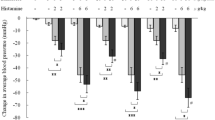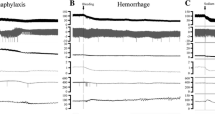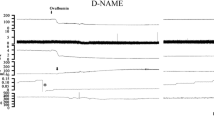Abstract
The heart is a target organ of anaphylaxis. In isolated perfused hearts, an anaphylactic reaction is characterized by arrhythmias, coronary constriction, and severe impairment of ventricular contractile force. Various mediators such as PAF, thromboxane A2 and leukotrienes, are responsible for anaphylactic coronary constriction and negative inotropic effects. The cardiac effects of anaphylactic histamine release are related to the stimulation of two antagonistic receptor types. Histamine induces atrioventricular conduction delay and constriction of the epicardial coronary vessels via H1-receptor stimulation. H2-receptors, however, mediatecoronary vasodilation and an increase in heart rate and myocardial contractility. It may therefore be concluded that administration of histamine H2-receptor antagonists is disadvantageous. During anaphylactic states, the cardiodepressive effects of the other mediators of anaphylaxis are unmasked, resulting in a sustained coronary constriction and impairment of myocardial contractility. To verify this speculation, we investigated the effects of H1- and H2-receptor antagonists on cardiovascular function of guinea pigs during systemic anaphylaxis.
In guinea pigs, sensitization was produced by subcutaneous application of ovalbumin. Fourteen days after sensitization, the effects of an intravenous infusion of ovalbumin were tested in the anesthetized artificially ventilated guinea pigs. The renewed administration of the antigen induced severe cardiac dysfunction. Within a few minutes, cardiac output markedly decreased and left ventricular end-diastolic pressure increased significantly, indicating left ventricular pump failure. In the same time range, ECG recordings uniformly showed signs of acute myocardial ischemia. In addition, arrhythmias occurred in terms of an atrioventricular block. After 4 min, blood pressure rapidly declined. All animals died within 12 min. Pretreatment with the selective H1-receptor antagonist astemizol (5 mg/kg i.v.) delayed the onset of myocardial ischemia, arrhythmias and cardiac pump failure. After 10 min, however, left ventricular contractility and blood pressure steadily declined, leading to severe hypotension within 30 min. In the case of a pretreatment with astemizol (5 mg/kg i.v.) and the H2-receptor antagonist famotidine (10 mg/kg i.v.), no relevant changes of cardiovascular function were seen compared to pretreatment with astemizol alone. It is therefore concluded that endogenous histamine, via H1-receptor stimulation plays an important part during the early phase of systemic anaphylaxis, whereas mediators other than histamine are involved at a later stage of the process. Furthermore, H2-receptor-mediated effects are of minor importance in cardiovascular manifestation of anaphylaxis. Pretreatment with H2-receptor antagonists has no detrimental effects on cardiovascular function during anaphylactic reactions in guinea pigs underin vivo conditions.
Similar content being viewed by others
References
R. Levi,Cardiac anaphylaxis: Models, mediators, mechanisms, and clinical considerations. InHuman inflammatory disease, clinical immunology, vol. 1. pp. 93–105 (Eds. G. Marone, L. M. Lichtenstein, M. Condorelli and A. S. Fauci) B. C. Decker, Inc., Toronto 1988.
H. Anhut, W. Bernauer and B. A. PeskarRadioimmunological determination of thromboxane release in cardiac anaphylaxis. Europ. J. Pharmacol.44, 85–88 (1977).
G. Allan and R. Levi,Thromboxane, and prostacyclin release during cardiac immediate hypersensitivity reactions in vitro. J. Pharmacol. Exp. Ther.217, 157–161 (1988).
U. Aehringhaus, B. A. Peskar, H. R. Wittenberg and R. H. Wölbling,Effect of inhibition of synthesis and receptor antagonism of SRS-A in cardiac anaphylaxis. Br. J. Pharmacol.80, 73–80 (1983).
P. Weinerowski, G. Wittmann, U. Aehringhaus and B. A. Peskar,Pharmacological modification of leukotriene release and coronary constrictor effect in cardiac anaphylaxis. InAdvances in prostaglandin, thromboxane and leukotriene research, vol. 13. pp. 47–50 (Ed. G. G. Neri Serneri) Raven Press, New York 1985.
R. Levi, J. A. Burke, Z.-G. Guo, Y. Hattori, C. M. Hoppens, L. M. McManus, D. J. Hanahan and R. N. Pinckard,Acetyl glyceryl ether phosphorylcholine (AGEPC) a putative mediator of cardiac anaphylaxis in the guinea pig. Circ. Res.54, 117–124 (1984).
J. H. McNeil and S. C. Verma,Blockade by burimamide of the effects of histamine and histamine analogs on cardiac contractility, phosphorylase activation and cyclic adenosine monophosphate. J. Pharmacol. Exp. Ther.188, 180–188 (1974).
R. Levi, N. Capurro, C.-H. Lee,Pharmacological characterization of cardiac histamine receptors: sensitivity to H 1- and H2-receptor agonists and antagonists. Eur. J. Pharmacol.30, 328–335 (1975).
R. Ginsburg, M. R. Bristow, E. B. Stinson and D. C. Harrison,Histamine receptors in the human heart. Life Sci.26, 2245–2249 (1980).
G. Baumann, S. B. Felix, J. Schrader, C. D. Heidecke, G. Riess, W. D. Erhardt, L. Ludwig, U. Loher, F. Sebening and H. Blömer,Cardiac contractile and metabolic effects mediated via the myocardial H 2-receptor adenylate cyclase system. Res. Exp. Med.179, 81–98 (1981).
G. R. Hageman, F. Urthaler, J. H. Isobe and T. N. James,Chronotropic and dromotropic effects of histamine on the canine heart. Chest75, 597–604 (1979).
G. Baumann, U. Loher, S. B. Felix, C. D. Heidecke, G. Riess, L. Ludwig and H. Blömer,Deleterious effects of cimetidine in the presence of histamine on coronary circulation. Possible clinical implications in anaphylactic states in individuals with coronary heart disease. Res. Exp. Med.180, 209–213 (1982).
J. T. Saari,Characterization of the vascular response to histamine in rabbit hearts using cimetidine. Pharmacology32, 80–89 (1986).
N. Toda,Mechanism of histamine actions in human coronary arteries. Circ. Res.61, 280–286 (1987).
S. B. Felix, G. Baumann, S. Helmus and U. Sattelberger,The role of histamine in cardiac anaphylaxis; characterization of histaminergic H1- and H2-receptor effects. Basic Res. Cardiol.83, 531–539 (1988).
G. Neumann, W. Erhardt, B. Oberhuber, R. Fritsch and G. Blümel,A new highly potent and short-acting analgesic, Carfentanyl (R33799) in combination with the hypnotic agent Etomidat (R26490), as a method of analgesia in guinea pigs. Res. Exp. Med.177, 135–143 (1980).
S. B. Felix, G. Baumann, T. Hashemi, M. Niemczyk, Z. Ahmad and W. E. Berdel,Characterization of cardiovascular events mediated by platelet activating factor during systemic anaphylaxis. J. Cardiovasc. Pharmacol.15, 989–997 (1990).
N. Capurro and R. Levi,The heart as a target organ in systemic allergic reactions. Comparison of cardiac anaphylaxis in vivo and in vitro. Circ. Res.36, 520–528 (1975).
E. T. Nishimura, R. Patterson, J. N. Fink and J. N. Wennemark,Myocardial lesions associated with experimental passive transfer of immediate type hypersensitivity. Lab. Invest.15, 1269–1278 (1966).
R. Patterson, J. N. Fink, J. Wennemark, J. Baum, J. Pruzansky and E. T. Nishimura,The biologic consequences of the immediate type hypersensitivity transferred from man to monkey. J. Allergy37, 295–310 (1966).
S. B. Felix, G. Baumann and W. E. Berdel,Systemic anaphylaxis—separation of cardiac reactions from respiratory and peripheral vascular events. Res. Exp. Med.190, 239–252 (1990).
K. Pavek, A. Wegmann, L. Nordström and D. Schwander,Cardiovascular and respiratory mechanisms in anaphylactic and anaphylactoid shock reactions. Klin. Wochenschr.60, 941–947 (1982).
H. J. Silvermann, C. Van Hook and E. F. Haponik,Hemodynamic changes in human anaphylaxis. Am. J. Med.77, 341–344 (1984).
A. Guhlmann, A. Keppler, S. Kästner, H. Krieter, U. B. Brückner, K. Messmer and D. Keppler,Prevention of endogenous leukotriene production during anaphylaxis in the guinea pig by an inhibitor of leukotriene biosynthesis (MK-886) but not by dexamethasone. J. Exp. Med.170, 1905–1918 (1989).
H. Darius, J. B. Smith and A. M. Lefer,Inhibition of the platelet activating factor mediated component of guinea pig anaphylaxis by receptor antagonists. Int. Archs. Allergy Appl. Immun.80, 369–375 (1986).
W. Lorenz and A. Doenicke,H 1 and H2 blockade: A prophylactic principle in anesthesia and surgery against histaminerelease responses of any degree of severity: Part I. N. Engl. Res. Allerg. Proc.6, 38–57 (1985).
W. Lorenz and A. Doenicke,H 1 and H2 blockade: A prophylactic principle in anesthesia and surgery against histaminerelease responses of any degree of severity: Part II. N. Engl. Res. Allerg. Proc.6, 174–192 (1985).
Author information
Authors and Affiliations
Additional information
Supported by grant Fe250/1-1 from the Deutsche Forschungsgemeinschaft (DFG).
Rights and permissions
About this article
Cite this article
Felix, S.B., Baumann, G., Niemczyk, M. et al. Effects of histamine H1- and H2-receptor antagonists on cardiovascular function during systemic anaphylaxis in guinea pigs. Agents and Actions 32, 245–252 (1991). https://doi.org/10.1007/BF01980881
Received:
Accepted:
Issue Date:
DOI: https://doi.org/10.1007/BF01980881




